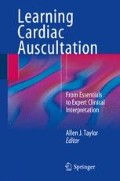Abstract
Mitral Valve Regurgitation (MR) is among the most common valvular diseases in the developed world, affecting 19 % of individuals in the United States. MR occurs when the mitral valve becomes incompetent as a result of a defect to any part of the mitral valve apparatus – the leaflets, chordae tendinae, papillary muscles, or mitral annulus. The location, time course, and extent of damage to the apparatus determine whether the pathology presents as Acute or Chronic MR. On physical exam, the classical holosystolic murmur of chronic MR is best heard over the apex, commencing immediately after S1 and continuing up to S2. It is most often “blowing,” high pitched in quality, and associated with a widening of S2. Acute MR is best heard along the left sternal border as an apical systolic murmur with early- and mid- systolic crescendo-decrescendo. Both Chronic and Acute MR may remain clinically asymptomatic or may lead to severely debilitating symptoms including dyspnea on exertion, orthopnea, and weakness. The presence of symptoms indicates progression to more severe disease and, therefore, is a poor prognostic indicator if not treated. While medical therapy may be an option in patients with milder disease, surgery is recommended in all patients with symptomatic severe MR or evidence of early systolic dysfunction.
Access this chapter
Tax calculation will be finalised at checkout
Purchases are for personal use only
References
Enriquez-Sarano M, Akin C, Vaharian A. Mitral regurgitation. Lancet. 2009;373:1381–94.
Schmitto JD, et al. Functional mitral regurgitation. Cardiol Rev. 2010;18(6):285–91.
Bonow RO, et al. ACC/AHA 2006 guidelines for the management of patients with valvular heart disease: executive summary a report of the American College of Cardiology/American Heart Association Task force on practice guidelines. Circulation. 2006;114:e84–231.
Ahmed MI, McGiffin DC, O’Rourke RA, Dell’Italia LJ. Mitral regurgitation. Curr Probl Cardiol. 2009;34(3):93–136.
Lehmann KG, Francis CK, Dodge HT. Mitral regurgitation in early myocardial infarctionincidence, clinical detection, and prognostic implications. Ann Intern Med. 1992;117(1):10–7.
Nkomo VT, et al. Burden of valvular heart diseases: a population-based study. Lancet. 2006;368(9540):1005–11.
Singh JP, et al. Prevalence and clinical determinants of mitral, tricuspid, and aortic regurgitation (the Framingham Heart Study). Am J Cardiol. 1999;83(6):897–902.
Rahko PS. Prevalence of regurgitant murmurs in patients with valvular regurgitation detected by Doppler echocardiography. Ann Intern Med. 1989;111:466.
Ronan JA, et al. The clinical diagnosis of acute severe mitral insufficiency. Am J Cardiol. 1971;27(3):284–90.
Chizner MA. The diagnosis of heart disease by clinical assessment alone. Curr Probl Cardiol. 2001;26:285–379.
Cohen LS, Mason DT, Braunwald E. Significance of an atrial gallop sound in mitral regurgitation: a clue to the diagnosis of ruptured chordae tendineae. Circulation. 1967;35(1):112–8.
McGee S. Etiology and diagnosis of systolic murmurs in adults. Am J Med. 2010;123(10):913.
Lembo NJ, Dell’Italia LJ, Crawford MH, O’Rourke RA. Bedside diagnosis of systolic murmurs. N Engl J Med. 1988;318:1572.
Chizner MA. Cardiac auscultation: rediscovering the lost art. Curr Probl Cardiol. 2008;33(7):326.
Perloff JK, Proctor Harvey W. Auscultatory and phonocardiographic manifestations of pure mitral regurgitation. Prog Cardiovasc Dis. 1962;5(2):172–94.
Desjardins VA, et al. Intensity of murmurs correlates with severity of valvular regurgitation. Am J Med. 1996;100:149–56.
Trichon BH, et al. Relation of frequency and severity of mitral regurgitation to survival among patients with left ventricular systolic dysfunction and heart failure. Am J Cardiol. 2003;91(5):538–43.
Delahaye JP, et al. Natural history of severe mitral regurgitation. Eur Heart J. 1991;12(Suppl B):5.
Bonow RO, Carabello BA, Chatterjee K, de Leon Jr AC, Faxon DP, Freed MD, Gaasch WH, Lytle BW, Nishimura RA, O'Gara PT, O'Rourke RA, Otto CM, Shah PM, Shanewise JS, 2006 Writing Committee Members; American College of Cardiology/American Heart Association Task Force. 2008 Focused Update Incorporated into the ACC/AHA 2006 Guidelines for the Management of Patients With Valvular Heart Disease. A Report of the American College of Cardiology/American Heart Association Task Force on Practice Guidelines (Writing Committee to Revise the 1998 Guidelines for the Management of Patients With Valvular Heart Disease): Endorsed by the Society of Cardiovascular Anesthesiologists, Society for Cardiovascular Angiography and Interventions, and Society of Thoracic Surgeons. Circulation. 2008;118:e523–661.
Author information
Authors and Affiliations
Corresponding author
Editor information
Editors and Affiliations
1 Electronic Supplementary Material
Video 9.1
MR in setting of presumptive ARF (Provided by Robin Winkler Doroshow, MD, Medstar Georgetown University Hospital, Washington, DC.) (MP4 1034 kb)
Video 9.2
Moderate to severe MR, as described by Dr. W. Proctor Harvey (File 149 from Clinical Cardiology by W. Proctor Harvey, MD, MACC, Jules Bedynek, MD, and David Canfield and published by Laennec Publishing Inc., Fairfield, NJ. Used with permission and copyrighted by Laennec Publishing, Inc. All rights reserved.) (MP4 12513 kb)
Video 9.3
Female patient with chronic significant MR, as described by Dr. W. Proctor Harvey (File 145 from Clinical Cardiology by W. Proctor Harvey, MD, MACC, Jules Bedynek, MD, and David Canfield and published by Laennec Publishing Inc., Fairfield, NJ. Used with permission and copyrighted by Laennec Publishing, Inc. All rights reserved.) (MP4 6002 kb)
Rights and permissions
Copyright information
© 2015 Springer-Verlag London
About this chapter
Cite this chapter
Kaufman, B., Sonne, C., Tsang, A.K. (2015). Mitral Regurgitation. In: Taylor, A. (eds) Learning Cardiac Auscultation. Springer, London. https://doi.org/10.1007/978-1-4471-6738-9_9
Download citation
DOI: https://doi.org/10.1007/978-1-4471-6738-9_9
Publisher Name: Springer, London
Print ISBN: 978-1-4471-6737-2
Online ISBN: 978-1-4471-6738-9
eBook Packages: MedicineMedicine (R0)

